
Home - Search - Browse - Alphabetic Index: 0- 1- 2- 3- 4- 5- 6- 7- 8- 9
A- B- C- D- E- F- G- H- I- J- K- L- M- N- O- P- Q- R- S- T- U- V- W- X- Y- Z
Dragon
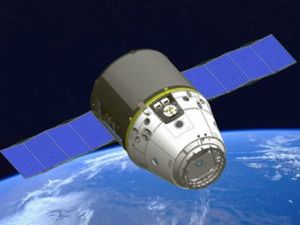 Dragon Credit: SpaceX |
Status: Operational 2010. First Launch: 1962-12-05. Last Launch: 1972-12-13. Number: 37 . Gross mass: 8,000 kg (17,600 lb). Height: 6.10 m (20.00 ft). Diameter: 3.60 m (11.80 ft). Apogee: 400 km (240 mi).
In September 2006 SpaceX was named as one of two winners of the NASA Commercial Orbital Transportation Services competition. The SpaceX award was $278 million for three flight demonstrations of the Falcon 9 booster carrying the Dragon space capsule. These were to occur in 2009. The third flight would demonstrate unmanned rendezvous and docking of the Dragon capsule with the International Space Station. The crew aboard the station would unload the capsule and fill it with return cargo. The Dragon would undock and return this cargo to earth.
An option to the agreement would fund three demonstration flights of the manned person of the Dragon, which could carry seven crew or a mixture of crew and cargo to the station and back. SpaceX estimated ISS resupply business could be worth as much as $500 million per year after retirement of the US shuttle in 2010.
The cargo and crew versions of Dragon were nearly identical, except for the special provisions added to the manned version: a crew escape system, a life support system, and displays and controls allowing the pilot to take manual control if necessary.
The Falcon 9/Dragon combination was also foreseen as a shuttle to the Bigelow commercial space station / hotel. Both the Falcon 9 and Dragon were to be fully reusable. The booster's two stages and the Dragon would all use parachutes for landings on water.
As of mid-2008 SpaceX was still working under its COTS contract, although three attempts to launch the basic Falcon 1 vehicle, much smaller than the Falcon 9, had failed. The Dragon spacecraft had reached mock-up and fabrication stage. It consisted of three main elements: the Nosecone, which protected the vessel and the docking adaptor during ascent; the Pressurized Section, which housed the crew or pressurized cargo; and the Service Section, which contained avionics, the RCS system, parachutes, and other support infrastructure. There was also an Unpressurized Trunk, which provided for stowage of unpressurized cargo and supported solar arrays and thermal radiators.
The spacecraft was designed for fully autonomous rendezvous and docking. The capsule had a pressurized volume of 18 cubic meters and a payload capacity of 2500 kg up to the station and back. A mix of up to seven astronauts with no payload; or any combination to 2500 kg of cargo and no crew, could be accommodated. For cargo launches the inside of the capsule was outfitted with a modular cargo rack system designed to accommodate pressurized cargo in standard sizes and form factors. For crewed launches, the interior was outfitted with crew couches, controls with manual override capability and upgraded life-support. The reaction control system, used for attitude control and orbital maneuvers and braking for re-entry, had 18 MMH/N2O4 bipropellant thrusters by SpaceX using 1200 kg of propellant
The capsule used an ablative heat shield for a lifting, low-G re-entry; followed by descent under a parachute and splashdown in the ocean.
Development Cost $: 278.000 million. Crew Size: 7.
More at: Dragon.
| Dragon C1 Supply and return satellite for SpaceX, USA. Launched 2010. |
| Dragon Qualifiaction Unit Vehicle evaluation payload for SpaceX, USA. Launched 2010. |
| Dragon v2 Manned spacecraft for SpaceX, USA. |
| Dragon v2 Flight History Dragon flight history. |
| Dragon v2 Abort Test Vehicle Manned spacecraft for SpaceX, USA. |
| DragonLab Material sciences satellite for SpaceX, USA. |
| Red Dragon Mars lander for SpaceX, USA. |
Family: Manned spacecraft, New Space Tourism. Country: USA. Engines: Draco. Launch Vehicles: Falcon 1, Falcon 9 v1.1, Falcon 9. Launch Sites: Hammaguira Bechar, Hammaguira Bacchus, Cape Canaveral LC40, Kourou ALFS. Agency: NASA, SpaceX. Bibliography: 12238, 12239, 12240.
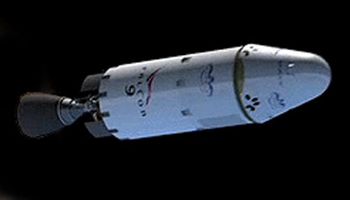 | Dragon/Falcon 9 Credit: Manufacturer Image |
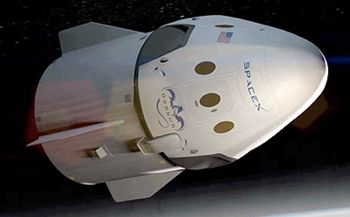 | Dragon v2 Credit: Manufacturer Image |
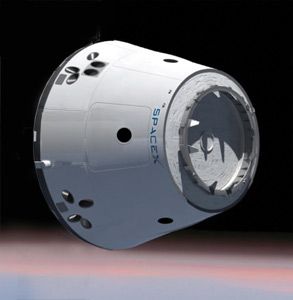 | Dragon C1 Credit: Manufacturer Image |
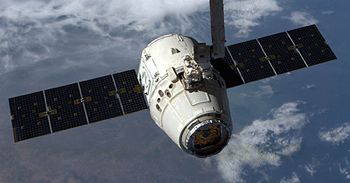 | Dragon C2 Credit: Manufacturer Image |
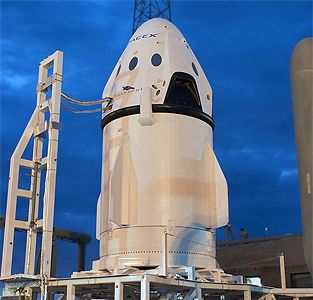 | Dragon v2 Abort Test Credit: Manufacturer Image |
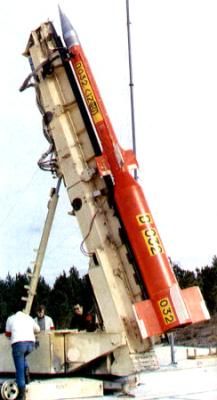 | Dragon Credit: via Jean-Jacques Serra |
2010 June 4 - . 18:45 GMT - . Launch Site: Cape Canaveral. Launch Complex: Cape Canaveral LC40. Launch Pad: SLC40. LV Family: Falcon. Launch Vehicle: Falcon 9.
- Dragon/Falcon 9 - . Mass: 4,000 kg (8,800 lb). Nation: USA. Agency: SpaceX. Class: Manned. Type: Manned spacecraft. Spacecraft: Dragon. Duration: 23.00 days. Decay Date: 2010-06-27 . USAF Sat Cat: 36595 . COSPAR: 2010-026A. Apogee: 140 km (80 mi). Perigee: 138 km (85 mi). Inclination: 34.50 deg. Period: 87.30 min. First launch of the commercial Falcon 9 launch vehicle. Structural model of Dragon reusable spacecraft. Remained attached to final stage..
2010 December 8 - . 15:43 GMT - . Launch Site: Cape Canaveral. Launch Complex: Cape Canaveral LC40. Launch Pad: SLC40. LV Family: Falcon. Launch Vehicle: Falcon 9.
- Dragon C1 - . Mass: 6,650 kg (14,660 lb). Nation: USA. Class: Manned. Type: Manned spacecraft. Spacecraft: Dragon. Duration: 0.14 days. Decay Date: 2010-01-12 . USAF Sat Cat: 37244 . COSPAR: 2010-066A. Apogee: 306 km (190 mi). Perigee: 281 km (174 mi). Inclination: 34.50 deg. Period: 90.40 min. First test of the Dragon recoverable spacecraft. Splashed down and successfully recovered in the Pacific Ocean 800 km west of Mexico after a 3 hour 20 minute mission..
2012 May 22 - . 07:44 GMT - . Launch Site: Cape Canaveral. Launch Complex: Cape Canaveral LC40. Launch Pad: SLC40. LV Family: Falcon. Launch Vehicle: Falcon 9.
- Dragon C2 - . Mass: 6,650 kg (14,660 lb). Nation: USA. Program: ISS. Class: Manned. Type: Manned spacecraft. Spacecraft: Dragon. Duration: 9.00 days. Decay Date: 2012-05-31 . USAF Sat Cat: 38348 . COSPAR: 2012-027A. Apogee: 406 km (252 mi). Perigee: 392 km (243 mi). Inclination: 51.60 deg. Period: 92.50 min. First commercial delivery of cargo to a space station. After rendezvous with the International Space Station, it was captured by the station's SSRMS robot arm on 25 May at 13:56 GMT. Berthed at the nadir CBM port of the Harmony module at 16:02 GMT..
2012 October 8 - . 00:35 GMT - . Launch Site: Cape Canaveral. Launch Complex: Cape Canaveral LC40. Launch Pad: SLC40. LV Family: Falcon. Launch Vehicle: Falcon 9.
- Dragon CRS-1 - .
Mass: 9,500 kg (20,900 lb). Nation: USA.
Program: ISS.
Class: Manned.
Type: Manned spacecraft. Spacecraft: Dragon.
Duration: 20.00 days. Decay Date: 2012-10-28 . USAF Sat Cat: 38846 . COSPAR: 2012-054A. Apogee: 425 km (264 mi). Perigee: 402 km (249 mi). Inclination: 51.60 deg. Period: 92.80 min.
One first stage engine had an anomaly at max Q (T+1:20) with some debris observed falling away; the engine was shut down but the remaining engines and the second stage compensated to reach the initial orbit. However, extra propellant was used and stage two did not restart as planned. Nevertheless Dragon reached the ISS on 10 October and was captured by the station's SSRMS arm at 10:56 GMT and berthed to the Harmony module at 13:03 GMT. Following unloading of the cargo delivered to the ISS and loading of experimental results and failed equipment for return to earth, the SSRMS unberthed Dragon at 11:19 GMT on 28 October and released it at 13:29 GMT. At 14:22 GMT the Dragon made a burn to lower its orbit and at 18:28 GMT came the 10 minute 40 second long deorbit burn. The Dragon trunk was jettisoned at 18:41 GMT and the capsule reached entry interface at 19:02 GMT. Splashdown in the Pacific Ocean was at around 123 deg W 28 deg N at 19:22
2013 March 1 - . 15:10 GMT - . Launch Site: Cape Canaveral. Launch Complex: Cape Canaveral LC40. Launch Pad: SLC40. LV Family: Falcon. Launch Vehicle: Falcon 9.
- Dragon CRS-2 - .
Mass: 9,500 kg (20,900 lb). Nation: USA.
Program: ISS.
Class: Manned.
Type: Manned logistics spacecraft. Spacecraft: Dragon.
Duration: 25.00 days. Decay Date: 2013-03-26 . USAF Sat Cat: 39115 . COSPAR: 2013-010A. Apogee: 409 km (254 mi). Perigee: 380 km (230 mi). Inclination: 51.65 deg. Period: 92.44 min.
Initial issues with thrusters and solar panel deployment were solved, but delayed rendezvous with the ISS by one day. Captured by the ISS SSRMS robot arm at 10:31 GMT on 3 March. Delivered 677 kg of cargo in the pressurized section. Externally, two 119 kg grapple fixtures for the ISS Heat Rejection System were delivered. Undocked and released by the SSRMS at 10:56 GMT on 26 March. Retrofire at 15:42 GMT followed by splashdown in the Pacific at 30.52 deg N / 120.04 deg W at 16:35 GMT.
2014 April 18 - . 19:25 GMT - . Launch Site: Cape Canaveral. Launch Complex: Cape Canaveral LC40. Launch Pad: SLC40. LV Family: Falcon. Launch Vehicle: Falcon 9.
- Dragon CRS-3 - .
Mass: 9,500 kg (20,900 lb). Nation: USA.
Program: ISS.
Class: Manned.
Type: Manned logistics spacecraft. Spacecraft: Dragon.
Duration: 30.00 days. Decay Date: 2014-05-18 . USAF Sat Cat: 39680 . COSPAR: 2014-022A. Apogee: 410 km (250 mi). Perigee: 398 km (247 mi). Inclination: 51.65 deg. Period: 92.65 min.
Placed in an initial 313 x 322 km orbit. The first flight of a Falcon 9 with experimental landing legs on the first stage. Falcon 9 stage 1 reignited during descent after reaching around 120 km, and touched down vertically on the ocean after demonstrating that it could maintain its orientation during the return from space. The Falcon 9 second stage carried five cubesats; after ejecting them, the stage was deorbited over the Indian Ocean and destroyed during reentry. The Dragon trunk carried the OPALS and HDEV experiments for laser communications and Earth imaging respectively. They would be installed on the ISS - JSC's HDEV on the Columbus module EPF, and JPL's OPALS for the ELC-1 platform. Spacesuit EMU 3003 was also aboard Dragon. Following unloading of cargo and reloading with items to be returned to earth, the hatch to Dragon CRS-3 was closed on May 17. Dragon was unberthed by the SSRMS Canadarm-2 at about 12:00 GMT May 18 and released at 13:26 GMT. The deorbit burn at 18:12 to 18:22 GMT was followed by trunk separation at about 18:24 GMT, atmosphere entry at 18:45 GMT and splashdown west of Baja California at 19:05 GMT. It was reported that some water leaked into the Dragon cabin after splashdown, but NASA said the cargo was not damaged.
2014 September 21 - . 05:52 GMT - . Launch Site: Cape Canaveral. Launch Complex: Cape Canaveral LC40. Launch Pad: Cape Canaveral SLC40. LV Family: Falcon. Launch Vehicle: Falcon 9 v1.1.
- Dragon CRS-4 - .
Mass: 9,500 kg (20,900 lb). Nation: USA.
Class: Manned.
Type: Manned logistics spacecraft. Spacecraft: Dragon.
Duration: 34.00 days. Decay Date: 2014-10-25 . USAF Sat Cat: 40210 . COSPAR: 2014-056A. Apogee: 412 km (256 mi). Perigee: 403 km (250 mi). Inclination: 51.64 deg. Period: 92.71 min.
ISS resupply mission. The Dragon Trunk carried two packages, the ISS RapidScat radar scatterometer science instrument and the RapidScat Nadir Adapter, which was to be installed on the SDX nadir attach point of the Columbus module's external payload facility. The Dragon cabin carried SpinSat, an 0.56m spherical NRL satellite to be deployed by the Kibo JEM-RMS, and the NASA-Ames Rodent Research 1 life sciences payload with 20 mice. The SSRMS Canadarm-2 grappled the Dragon at 10:52 GMT on September 23 and berthed it to the Harmony node at 13:21 GMT. Unberthed and released by the SSRMS at 13:57 GMT on 25 October. It made its deorbit burn at 18:43 GMT and splashed down in the Pacific Ocean at 19:38 GMT off Baja California near 34 deg N x 123.5 deg W.
2015 January 10 - . 09:47 GMT - . Launch Site: Cape Canaveral. Launch Complex: Cape Canaveral LC40. Launch Pad: Cape Canaveral SLC40. LV Family: Falcon. Launch Vehicle: Falcon 9 v1.1.
- Dragon CRS-5 - .
Mass: 9,500 kg (20,900 lb). Nation: USA.
Class: Manned.
Type: Manned logistics spacecraft. Spacecraft: Dragon.
Duration: 32.00 days. Decay Date: 2015-02-11 . USAF Sat Cat: 40370 . COSPAR: 2015-001A. Apogee: 408 km (253 mi). Perigee: 400 km (240 mi). Inclination: 51.70 deg.
Launched into a 206 km x 353 km x 51.6 deg orbit. The 9700 kg spacecraft carried 1823 kg of internal cargo and the 494 kg CATS lidar experiment from NASA-GSFC in the trunk. Inside Dragon were two PlanetLabs Flock-1d' cubesats and the AESP-14 1U cubesat from Brazil's space agency AEB and the ITA technical institute. On January 12 Dragon was grappled by the SSRMS arm at 10:54 GMT and berthed on the Harmony module at 13:54 GMT. The cubesats were transferred internally to the Kibo module and were to be deployed from the Kibo airlock. CATS was grappled by the Dextre robot on 2015 Jan 22 and unberthed from Dragon around 07:00 GMT; it was then handed off to the JEM-RMS at around 10:30 and installed on the Kibo Exposed Facility at location EFU3 at about 14:00. The Falcon 9 first stage performed a flyback attempt to land around 360 km downrange at 78 deg W / 31 deg N. The stage made a 'hard' landing on the ASDS (Autonomous Spaceport Drone Ship). The first stage was destroyed when hydraulic fluid depletion made it tip over ahd hit the deck sideways, but the incident did not cause serious damage to the ship. The ASDS has now been renamed "Just Read The Instructions" after the name of an AI spaceship in the book 'The Player of Games' by the late science fiction writer Iain M. Banks.
Dragon CRS-5 was unberthed from the ISS Harmony module on February 10 by the SSRMS arm, which released it at 19:10 GMT. The Dragon made its deorbit burn at 23:49 GMT, with trunk separation at 00:05 GMT February 11 and splashdown at about 00:44 GMT. Six of the PlanetLabs Flock-1b cubesats (Nos. 3, 4, 13, 14, 19, 20) were returned to Earth aboard CRS-5 without having been deployed, after 212 days in space.
2015 April 14 - . 20:10 GMT - . Launch Site: Cape Canaveral. Launch Complex: Cape Canaveral LC40. Launch Pad: Cape Canaveral SLC40. LV Family: Falcon. Launch Vehicle: Falcon 9 v1.1.
- Dragon CRS-6 - .
Mass: 9,500 kg (20,900 lb). Nation: USA.
Class: Manned.
Type: Manned logistics spacecraft. Spacecraft: Dragon.
Duration: 37.00 days. Decay Date: 2015-05-21 . USAF Sat Cat: 40588 . COSPAR: 2015-021A. Apogee: 360 km (220 mi). Perigee: 205 km (127 mi). Inclination: 51.60 deg.
ISS resupply mission. Delivered into a 206 x 357 km orbit. Attempted recovery of the Falcon 9's first stage failed. It was flown down to the barge 'Just Read The Instructions' in the Atlantic but a stuck valve caused control problems in the final burn and the stage crash-landed. The Dragon itself arrived at ISS on April 17. The SSRMS arm grappled CRS-6 at 10:55 GMT and berthed it on the Harmony module at 13:29 GMT. After unloading and packing with materials to be returned to earth, the cargo ship was unberthed again around 09:29 GMT May 21, released at 11:04 GMT, and splashed down in the Pacific at 16:42 GMT.
CRS-6 carried 16 cubesats: 14 3U-size Flock-1e for Planet Labs, one Arkyd-3R for Planetary Resources (also a 3U) and a 1U cubesat, Centennial-1, for Booz Allen Hamilton carrying an Air Force Research Lab imaging experiment. The cubesats were transferred to the Kibo module after Dragon docking and later ejected into orbit via the NanoRacks deployers and the Kibo robot arm. CRS-6 also carried a number of mice aboard the Rodent Research 2 package, and a 20 kg microgravity-qualified Lavazza espresso machine.
2015 June 28 - . 14:21 GMT - . Launch Site: Cape Canaveral. Launch Complex: Cape Canaveral LC40. Launch Pad: Cape Canaveral SLC40. LV Family: Falcon. Launch Vehicle: Falcon 9 v1.1. FAILURE: Failed close to the end of stage 1 burn. A strut holding an internal helium pressurization tank broke during second stage initialization at T+139 sec at 45 km altitude. The resulting overpressure caused the second stage to blow apart.. Failed Stage: 2.
- Dragon CRS-7 - . Mass: 9,500 kg (20,900 lb). Nation: USA. Program: ISS. Class: Manned. Type: Manned logistics spacecraft. Spacecraft: Dragon. Apogee: 45 km (27 mi). Perigee: -6,250 km (-6,250 mi). Inclination: 51.60 deg. Dragon capsule CRS-7 was lost in the Atlantic, with its cargo which included 8 Flock 1f cubesats, the IDA-1 docking adapter, spacesuit EMU 3017, and the second NORS oyxgen recharge tank (the first one was lost on the Orb-3 failure in 2014)..
2016 April 8 - . 20:43 GMT - . Launch Site: Cape Canaveral. Launch Complex: Cape Canaveral LC40. Launch Pad: Cape Canaveral SLC40. LV Family: Falcon. Launch Vehicle: Falcon 9 v1.2.
- Dragon CRS-8 - .
Nation: USA.
Class: Manned.
Type: Manned logistics spacecraft. Spacecraft: Dragon.
Decay Date: 2016-05-11 . USAF Sat Cat: 41452 . COSPAR: 2016-024A. Apogee: 353 km (219 mi). Perigee: 209 km (129 mi). Inclination: 51.70 deg.
Falcon 9 F9-023 launched a Dragon with the Bigelow BEAM inflatable module experiment in its trunk. CRS-8 was scheduled to arrive at ISS on Apr 10. The F9-023 first stage performed boostback and reentry burns to successfully land on the ship "Of Course I Still Love You" at 78.50W 30.50N in the Atlantic. This was the second succesful reentry and landing of a Falcon 9 first stage, following the Dec 2015 landing of F9-021 at Cape Canaveral. Dragon CRS-8 arrived at the capture point 10m from the Harmony module at 1115 UTC Apr 10. The Canadarm-2 grappled it at 1123 UTC and berthed it on Harmony's nadir CBM port at 1357 UTC. At about 0600 UTC on Apr 16 the BEAM module was extracted from Dragon's trunk; BEAM was installed on the Tranquility module's aft port at 0937 UTC Apr 16. CRS-8 was unberthed at 1102 UTC May 11 and released into space at 1319 UTC. After a deorbit burn at 1801 UTC it splashed down around 120.1W 31.4N, off the coast of California, at 1851 UTC. The CRS-8 Dragon brought back to Earth the EMU 3011 spacesuit implicated in the Parmitano and Kopra water leaks. EMU 3011 was launched into space on mission STS-132 in 2010. Also brought back aboard CRS-8 were the Flock-2b 11 and 12 cubesats which failed to deploy from the ISS last October. Nanoracks deployers NRCSD-5 and NRCSD-6 were also returned to Earth on CRS-8. The Bigelow Expansion Activity Module (BEAM) remains attached to Node 3. On May 28 the module expansion was successfuly carried out; the process of expanding and pressurizing the module took from 1305 to 2044 UTC. The diameter of the module was 3.2metres; its length was increased by 1.8m to about 3.7m.
2016 July 18 - . 04:45 GMT - . Launch Site: Cape Canaveral. Launch Complex: Cape Canaveral LC40. Launch Pad: Cape Canaveral SLC40. LV Family: Falcon. Launch Vehicle: Falcon 9 v1.2.
- Dragon CRS-9 - .
Nation: USA.
Class: Manned.
Type: Manned logistics spacecraft. Spacecraft: Dragon.
Decay Date: 2016-08-26 . USAF Sat Cat: 41672 . COSPAR: 2016-046A. Apogee: 355 km (220 mi). Perigee: 204 km (126 mi). Inclination: 51.60 deg.
SpaceX's Dragon CRS-9 cargo ship carried the IDA-2 docking adapter and spacesuit EMU 3006. The Falcon 9 first stage returned to Cape Canaveral for a landing at Landing Complex 1. The second stage was deorbited south of Australia. CRS-9 arrived at the ISS on Jul 20; it was grappled by the SSRMS at 1056 UTC and berthed at Harmony nadir at 1403 UTC. The IDA-2 docking adapter will be installed on the end of the old PMA-2 Shuttle docking port to conver On Aug 25 at about 2100 UTC the SSRMS (Canadarm-2) unberthed Dragon CRS-9 from the Harmony module. At 1011 UTC the Dragon was released into orbit; at 1456 UTC Dragon fired its Draco thrusters in a deorbit burn which sent it plunging into the atmosphere at about 1520 UTC. The empty trunk was jettisoned at 1513 UTC. Dragon splashed down off the coast of Baja at 1547 UTC. Spacesuit EMU 3005 was returned to Earth aboard CRS-9.
2017 February 19 - . 14:39 GMT - . Launch Site: Cape Canaveral. Launch Complex: Cape Canaveral LC39A. LV Family: Falcon. Launch Vehicle: Falcon 9 v1.2.
- Dragon CRS-10 - .
Nation: USA.
Program: ISS.
Class: Manned.
Type: Manned logistics spacecraft. Spacecraft: Dragon.
Decay Date: 2017-03-19 . USAF Sat Cat: 42053 . COSPAR: 2017-009A. Apogee: 359 km (223 mi). Perigee: 204 km (126 mi). Inclination: 51.60 deg.
See Dragon CRS-10 (SpX 10, Dragon C112). Dragon CRS-10 was launched from Kennedy Space Center LC39A aboard a SpaceX Falcon 9; the first non-NASA launch operation ever from KSC and the first launch from KSC since 2011. NASA KSC abuts USAF Cape Canaveral Air Force Station on its northern side; previous Falcon 9 east coast launches were from SLC40 at Cape Canaveral. On this flight the Falcon 9 first stage, B1031, landed at Cape Canaveral's LZ1. CRS-10 carried three packages in its trunk for installation on ISS. The USAF Space Test Program's STP-H5 experiment suite includes a NASA lightning sensor and NRL ionosphere-study experiments. SAGE-III IP continued a long series of NASA ozone monitoring studies. SAGE-III NVP (Nadir Viewing Platform) was an adapter which will allow the IP to be installed sideways on the ISS ELC platform. On Feb 22 Dragon aborted its approach to the ISS at a distance of 1.2 km due to a navigation system error. Rendezvous was rescheduled for Feb 23 when Dragon was grappled by the SSRMS at 1044 UTC, then berthed on the Harmony module. he Dextre and Canadarm-2 robot arms were used to unload the experiments in the Dragon external cargo trunk on Feb 25-Mar 7 in a rather complicated sequence involving Dextre's two main arms and its EOTP (Enhanced ORU Temp Platform, a storage position). The experiments were installed on the Express Logistics Carriers ELC-1 and ELC-4 on the station truss. Older experiments from ELC-1, ELC-2 and ELC-4 were removed for disposal. These incuded the These included the OPALS laser comm payload launched in 2014; the RRM Robotic Refuelling Mission experiment of 2011, and the MISSE FSE adapter that mounted the MISSE 7 and 8 materials exposure experiments of 2009. These packages, with a total mass of 811 kg, were destroyed on reentry when the Dragon trunk was jettisoned following Dragon's deorbit burn. Dragon was unberthed from the Harmony module at 2145 UTC Mar 18 and released by Canadarm-2 at 0911 UTC Mar 19. After a deorbit burn at 1355 UTC it splashed down in the Pacific near 31 44N 121 15W at 1446 UTC, carrying 1652 kg of ISS return cargo. This return cargo includd 104 kg of unspecified EVA equipment.
2017 June 3 - . 21:06 GMT - . Launch Site: Cape Canaveral. Launch Complex: Cape Canaveral LC39A. LV Family: Falcon. Launch Vehicle: Falcon 9.
- Dragon CRS-11 - . Payload: Dragon C106. Nation: USA. Program: ISS. Class: Manned. Type: Manned logistics spacecraft. Spacecraft: Dragon. USAF Sat Cat: 42744 . COSPAR: 2017-030A. Apogee: 407 km (252 mi). Perigee: 392 km (243 mi). Inclination: 51.64 deg. Period: 92.54 min. See Dragon CRS-11 (SpX 11, Dragon C106-F2). ..
2017 August 14 - . 16:30 GMT - . Launch Site: Cape Canaveral. Launch Complex: Cape Canaveral LC39A. LV Family: Falcon. Launch Vehicle: Falcon 9.
- Dragon CRS-12 - . Payload: Dragon C113. Nation: USA. Program: ISS. Class: Manned. Type: Manned logistics spacecraft. Spacecraft: Dragon. USAF Sat Cat: 42904 . COSPAR: 2017-045A. Apogee: 398 km (247 mi). Perigee: 393 km (244 mi). Inclination: 51.64 deg. Period: 92.47 min. See Dragon CRS-12 (SpX 12, Dragon C113). ..
2017 December 15 - . 15:35 GMT - . Launch Site: Cape Canaveral. Launch Complex: Cape Canaveral LC40. LV Family: Falcon. Launch Vehicle: Falcon 9.
- Dragon CRS-13 - . Payload: Dragon C108. Nation: USA. Program: ISS. Class: Manned. Type: Manned logistics spacecraft. Spacecraft: Dragon. USAF Sat Cat: 43060 . COSPAR: 2017-080A. Apogee: 407 km (252 mi). Perigee: 393 km (244 mi). Inclination: 51.65 deg. Period: 92.56 min. See Dragon CRS-13 (SpX 13, Dragon C108-F2). ..
2018 April 2 - . 20:29 GMT - . Launch Site: Cape Canaveral. Launch Complex: Cape Canaveral LC40. LV Family: Falcon. Launch Vehicle: Falcon 9.
- Dragon CRS-14 - . Payload: Dragon C110. Nation: USA. Program: ISS. Class: Manned. Type: Manned logistics spacecraft. Spacecraft: Dragon. USAF Sat Cat: 43267 . COSPAR: 2018-032A. Apogee: 407 km (252 mi). Perigee: 402 km (249 mi). Inclination: 51.64 deg. Period: 92.65 min. See Dragon CRS-14 (SpX 14). ..
2018 June 29 - . 09:41 GMT - . Launch Site: Cape Canaveral. Launch Complex: Cape Canaveral LC40. LV Family: Falcon. Launch Vehicle: Falcon 9.
- Dragon CRS-15 - . Payload: Dragon C111. Nation: USA. Program: ISS. Class: Manned. Type: Manned logistics spacecraft. Spacecraft: Dragon. USAF Sat Cat: 43522 . COSPAR: 2018-055A. Apogee: 409 km (254 mi). Perigee: 402 km (249 mi). Inclination: 51.64 deg. Period: 92.68 min. See Dragon CRS-15 (SpX 15, Dragon C111-F2). ..
2018 December 5 - . 18:15 GMT - . Launch Site: Cape Canaveral. Launch Complex: Cape Canaveral SLC40. LV Family: Falcon. Launch Vehicle: Falcon 9.
- Dragon CRS-16 - . Nation: USA. Program: ISS. Class: Manned. Type: Manned logistics spacecraft. Spacecraft: Dragon. USAF Sat Cat: 43827 . COSPAR: 2018-101A. Apogee: 405 km (251 mi). Perigee: 395 km (245 mi). Inclination: 51.64 deg. Period: 92.56 min. See Dragon CRS-16 (SpX 16, Dragon C112-F2). ..
Back to top of page
Home - Search - Browse - Alphabetic Index: 0- 1- 2- 3- 4- 5- 6- 7- 8- 9
A- B- C- D- E- F- G- H- I- J- K- L- M- N- O- P- Q- R- S- T- U- V- W- X- Y- Z
© 1997-2019 Mark Wade - Contact
© / Conditions for Use